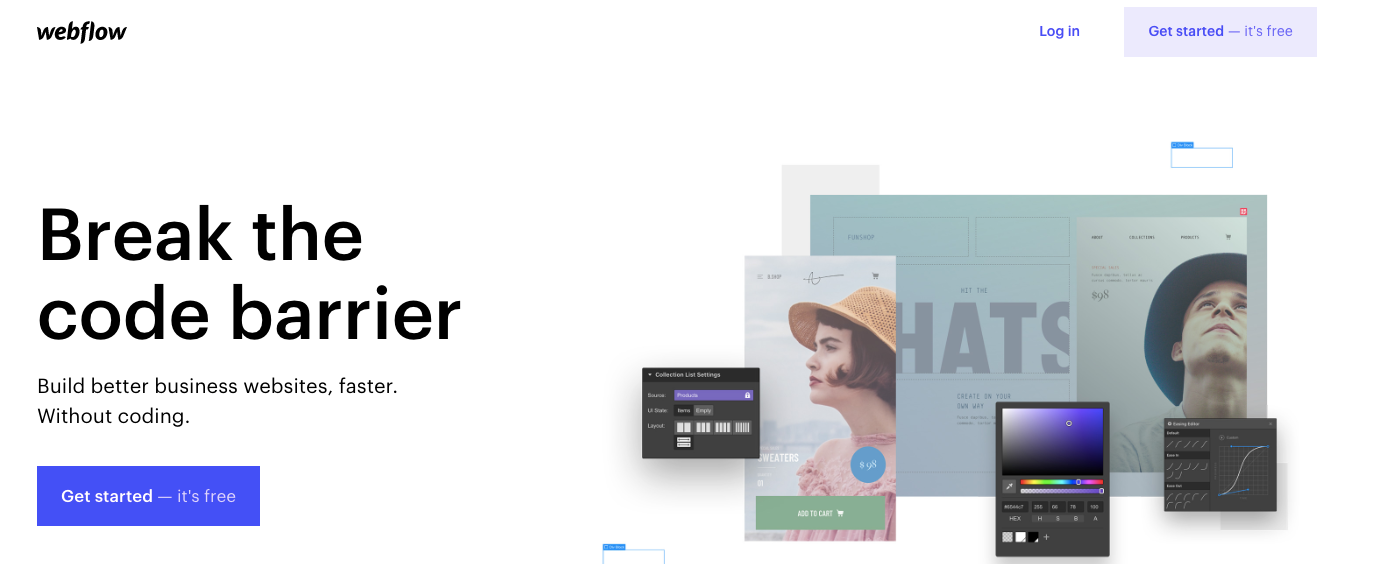Discover popular no-code apps that can help you build and automate your next startup — without writing a single line of code.
We’ve all heard success stories about those startups that began in someone’s garage and went on to become large businesses. We love hearing about underdogs rising up and winning. Today’s no-code tools allow businesses to be the underdogs — enabling them to build and launch without the need to write code.
14 no-code development platforms for businesses
From launching websites, building workflow automations, and developing apps, no-code platforms can help startups quickly build and launch.
Here are 14 no-code solutions to help you with your own startup and make what you need to do easier.
1. Webflow

Okay, we’re going to start this list with us. It’s our blog, right? But seriously, we are passionate about empowering everyone with the development tools to build professional websites. Webflow grants you the ability to create whatever website you’d like without knowing a single line of code — from SaaS websites to ecommerce stores.
With a variety of templates to get you started, and an intuitive drag-and-drop user interface, you’ll be able to bring your website from idea to launch quickly. Whether you want to start with a responsive template or build from scratch, Webflow allows full customization. Visual coding and development lets anyone take what's in their imagination and turn it into a working product.

Most startups don’t have a huge budget to spend on a website. Webflow gives you an affordable entry, letting you put up a high-quality website without spending a huge amount of time or money.
2. Scapic

Shopping online may be convenient, but not being able to see a product in person has its limitations. When looking through products on an ecommerce site, people want all of the details they can get. Photos are valuable, but they don’t always capture a true representation. This is where augmented reality comes in.
Scapic puts the power of augmented reality into your own online store — no coding required. People browsing through your products get a 360-degree view of what you’re offering. This gives them a much better representation of your products.
Having this flashy AR feature on your startup website may be what differentiates you from the competition. Scapic makes it easy to add this attention-grabbing tech into your own design.

3. Mailchimp

Building a startup means growing and understanding your audience.
Mailchimp’s platform includes all you need to collect customer information, analyze who they are, and get in touch with them.
You can conduct surveys, launch social media campaigns, and categorize your customer databases from Mailchimp’s all-in-one marketing platform. They also offer a number of no-code integrations with software like Square and LiveChat, making it versatile and simple to automate whatever you need.
Growing your customer base and communicating with them is important, especially at the beginning stages of a startup. Mailchimp’s web app makes this a faster and smarter process.
4. Parabola

Integrating data into automations and connecting apps can be a pain. Parabola makes all of this manageable. Whether it's an API, external database, or the intricacies of ecommerce, Parabola streamlines connecting and automating data-related tasks in a visually driven user experience.
With Parabola’s drag-and-drop tools you can automate a process or create a workflow. Whether your data is in Salesforce, Mailchimp, Shopify, or one of the other multitudes of platforms they support, Parabola is an indispensable data management tool for your business.
5. Voiceflow

As recently as a few years ago, it was hard to imagine how far voice-activated technology would come. Siri and Alexa were once strangers, but now they're our best friends, giving us the information we're after and fielding our weird questions when we're bored (we've all asked Siri if she could pass the Turing test — or is it just me?).
Voice apps shouldn’t just be limited to people who know how to program. Voiceflow makes voice app development for Alexa tools and Google actions possible for everyone without entering even a single line of code.
Creating a voice app involves arranging drag-and-drop blocks, which builds the logic and structure for rapid application development. It’s a simple visual interface that removes all of the complexity.
If you’re an aspiring app creator who has always wanted to build something for Google or Alexa, Voiceflow’s no-code application development platform lets you do just that.

6. Bubble

No-code also removes the obstacles to software development. Bubble lets you build your own app without having to know any programming languages.
Bubble gives aspiring app developers a visual set of components to assemble and launch fully functioning end products. A lot of options for functional customization makes Bubble a powerful tool for software development and building apps.
Bubble allows anyone who has an idea to build, prototype, and launch it into the world. No-code opens the gateway for creatives to make their dreams happen, no matter what their skillsets may be.

7. Makerpad

You may know a little bit about what no-code can do but want to learn more. Maybe you’d like to create something, but don’t even know if anything out there can help you. Makerpad has tutorials, tools, case studies, new apps, and other resources to help anyone find a solution for what they want to do.
Along with these resources, Makerpad has paid services that offer education, implementation, and support to startups with no-code solutions.
If you’re looking for an extensive collection of all things no-code, Makerpad has so much to offer.
source :
Jeff Cardello February 28, 2020
February 28, 2020
No comments:
Post a Comment